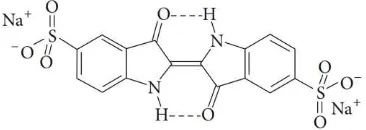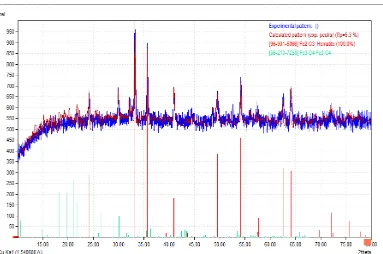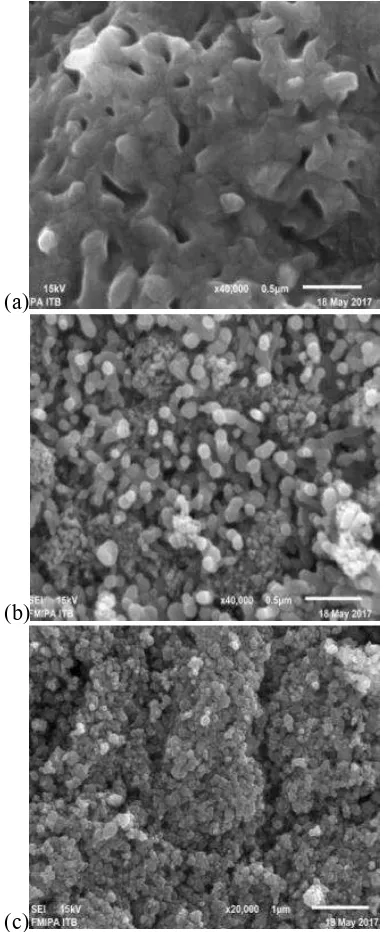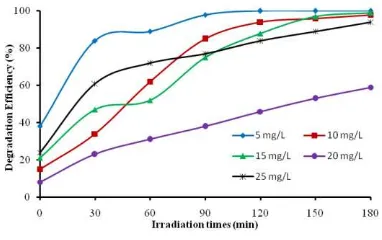Vol.18, (1) 2018 DOI 10.24815/jn.v18i1.8649
Published February 2018 pISSN 1411-8513 eISSN 2541-4062
38
SYNTHESIS AND CHARACTERIZATION OF TiO
2/
-Fe
2O
3COMPOSITE USING HEMATITE FROM IRON
SAND FOR PHOTODEGRADATION REMOVAL OF
DYE
Surya Lubis
*, Ilham Maulana and Masyithah
Department of Chemistry, Faculty of Mathematics and Natural Sciences, Syiah Kuala
University, Banda Aceh, Indonesia
*corresponding Author E-mail: [email protected]
Abstract. In this paper, TiO2/α-Fe2O3 composite with high photocatalytic activity was prepared by a mechanical milling using iron sand from Lampanah in Aceh Besar regency as hematite (α-Fe2O3) source. Hematite was extracted from iron sand by using hydrochloric acid followed by co-precipitating using ammonium hydroxide as co-precipitation agent. Hematite and TiO2 powder were mixed and milled on a planetary ball mill without incorporating any solvent. The materials were characterized by using X-ray difraction (XRD) and scanning electron microscopy energy dispersive x-ray spectroscopy (SEM-EDX). The XRD results showed that the iron (III) oxide synthesized was hematite (α-Fe2O3) phase with the average crystallite size 27.967 nm. SEM analysis showed that iron sand was on irregular form, while the hematite (α-Fe2O3) and TiO2/α-Fe2O3 composite was on regular sphere. The TiO2/α-Fe2O3 composite was evaluated on photodegradation of indigo carmine (IC) dye using UV light irradiation. The highest degradation efficiency of IC (100%) was obtained by initial pH of dye solution equal to 1, photocatalyst dosage of 0.2 g, initial dye consentration of 5 mg/L for 120 min irradiation time. The photocatalytic activity of TiO2/α-Fe2O3 composites using UV light was slightly higher than that of by solar light.
Keywords: Iron sand, α-Fe2O3/TiO2 composite, mechanical milling, photocatalyst, indigo carmine
I INTRODUCTION
Iron sand is a type of sand with a significant concentration of iron that is usually dark gray or blackish in colour. Iron sand is one of an abundant natural resources in Aceh province and based on Department of Mines and Energy of Aceh data there are about 36.800.000 tons of iron sand deposits in Aceh Besar regency [1]. Iron sand from Aceh Besar regency is composed mainly of magnetite (Fe3O4) and small amount of TiO2 and SiO2 [2]. Iron sand was used as raw materials in the steel and cement industries. Hematite (-Fe2O3) which can be extracted from iron sand is used in a wide range of applications such as in lithium
ion batteries, gas sensors, fine ceramics,
pigments, photo anode in photo-electrochemical cells, field effect transistor and catalysts [3, 4]. Hematite is stable under ambient conditions, resistance to corrosion and the semiconductor properties of hematite with a band gap of 2.2 eV are highly beneficial in photocatalysis. The small band gap of hematite make it efficient absorption in the solar spectrum. However, the small band gap result in undesired
__________________________________________________________________________________________________ extracted from iron sand by co-precipitation method and modified with TiO2 by mechanical milling. Crystallite size and surface morphologies of the extracted hematite ( -mill for 30 min with a -milling speed of 250 rpm until they completely passed through a 150 mesh standard sieve. Hematite (α- Fe2O3) was extracted from iron sand using hydrochloric acid followed by co-precipitation method according to previous works [10, 11]. A 50 g of iron sand sample was dissolved in 280 mL of 6M HCl solution with constant stirring and gently heating at 145C for 30 min. The solution was filtered and ammonium hydroxide 25% was added by drops to the filtrated solution until the pH reaches 6 at which ferric hydroxide was obtained as a brown precipitate. The precipitate was filtered, washed with distilled water, dried at 100C for 3 h and calcined at 700C for 5 h. The crystal phase of the product was identified by X-ray diffraction (XRD) using CuK radiation. A TiO2/α-Fe2O3 composite was synthesized by mechanical milling method using ballmill with the mole ratio of TiO2 to α-Fe2O3 1:3. The powder were mixed and milled for 12 h at the milling speed of 300 rpm with the balls to powder mass ratio was 10:1. The mixture was calcined at 500°C indigo carmine dye (IC) in an aqueous solution containing of 5, 10, 15, 20 and 25 mg/L IC as 466.36 g/mole) is a group of dark blue indigoid (Figure 1). The UV light source was a 6 W UV lamp ( = 365 nm). The mixture was magnetically stirred in the dark for 30 min to establish adsorption-desorption equilibrium of IC and the composite surface before the irradiation. A 3 mL sample solution was drawn from the system at a certain time interval (0, 30, 60, 90, 120 and 180 min) during the experiment, and then was centrifuged and analyze at 610 nm recording the characteristic absorption peak of IC with a UV-Vis spectrophotometer (Shimadzu UV mini 1240). The adsorption experiment was performed under the same condition without UV light irradiation. The degradation efficiency (%) of IC was calculated using the formula of Eqs. (2).
100% the IC solution before and after irradiation.Figure 1 The structure of indigo carmine dye
III RESULT AND DISCUSSION
__________________________________________________________________________________________________
40 Figure 2 X-ray difraction pattern of α-Fe2O3 synthesized from iron sand
The diffraction peaks found at 24.22, 33.22, 35.70 , 40.92, 49.52, 54.26, 57.34, 62.62, 64.06, 72.08 and 75.62 are consistent with those of hematite (-Fe2O3) (Crystalography Open Database (COD) Inorganic Rev. 9015964). Hematite (α-Fe2O3) was used to synthesize TiO2/α-Fe2O3 composite with the molar ratio of TiO2 to α-Fe2O3 1:3. Figure 3 presented the XRD patterns of iron sand, with diffraction peaks at 30.26, 35.72, 43.24, 54.18, 56.92 and 62.56. These diffraction peaks are corresponding to the reflection planes of magnetite (Fe3O4) (Crystalography Open Database (COD) Inorganic Rev. 1537396). It can be deduced that the main component of iron sand taken from Lampanah Beach, Aceh Besar regency was magnetite (Fe3O4).
Figure 3 XRD patterns of iron sand, hematite, TiO2/α-Fe2O3 composite and TiO2 samples
The diffraction peaks of TiO2 and hematite (α -Fe2O3) can be observed in XRD patterns of TiO2/α-Fe2O3 composite. The peaks at 2 are 25.27, 38.54, 48.01, 53.85, 62.65, 68.72, 75.01 and 76.02 correspond to the crystal planes of anatase (JCPDF file No.04-0477). Other observable difference in the XRD patterns of TiO2/α-Fe2O3 composite is the decrease intensity of the main peaks of hematite
(α-Fe2O3) due to coorporation of two semiconductors.
The average crystallite size of as-prepared materials calculated from XRD data by using Debye-Scherer equation were given in Table 1. It can be seen that the average crystallite size of TiO2/α-Fe2O3 composite was higher than that of iron sand and hematite. This is probably due to high-energy impact between miling balls and the mixture of TiO2 and α-Fe2O3 leading to the formation of agglomerate of TiO2/α-Fe2O3 composite.
Table 1 Average crystallite size of iron sand, hematite, TiO2 and TiO2/α-Fe2O3 composite
Sample Particle size
(nm)
Iron sand 33.144
Hematite 27.967
TiO2 45.361
TiO2/α-Fe2O3Composite 40.616
__________________________________________________________________________________________________
41 sand was irregular in shape while hematite
obtained from iron sand (Figure 4b) was in spherical regular and almost uniform in particle size. TiO2/α-Fe2O3 composite (Figure 4c) was in spherical form and slightly agglomerated probably due to the formation of high heat energy during the mechanical milling process. Energy dispersive X-ray spectroscopy (EDX) was used to determine the Fe to Ti mass ratio. The result exhibited that Fe and Ti was 53.72% and 33.51% (weight %) and thus the mass ratio of Fe to Ti was about 3:2.
(a)
(b)
(c)
Figure 4 SEM images of (a) Iron sand (b) α- Fe2O3 (c) TiO2/α-Fe2O3 composite
Photocatalytic Activity of TiO2/α-Fe2O3
The effect of pH on the photocatalytic degradation of indigo carmine (IC) over
TiO2/α-Fe2O3 composite studied in the range of pH 1-3 as a function of time is presented in Figure 5. It was exhibited that degradation efficiency of IC significantly improved on the lower pH and IC was degraded up to 99% at pH 1. This may be due to the fact that the pH of dye solution affects the surface properties of photocatalyst. In the acidic solutions, the surface charge properties of -Fe2O3 change to the positive charge (FeOH+), while in the basic solution the surface is negative charge. On the other hand, the surface of the TiO2 is negative potential in the range of pH>3, and the surface is positively charged under pH<3 [14].
Figure 5 Effect of pH on IC degradation efficiency over TiO2/α-Fe2O3 composite. Initial dye concentration of 15 mg/L and photocatalyst dosage 0.2 g
IC molecule has negative site and electrostatic attraction between anionic dye and the positive site of -Fe2O3 or TiO2 occurred (Figure 6). Thus IC molecule can easily react with the holes or OH radical generated on the surface of TiO2/α-Fe2O3 composite when irradiated by UV light. With increasing pH, the negative charges on TiO2 and α-Fe2O3 repel the dye molecule and decrease the efficiency of photodegradation.
Ti – O Ti – OH
Ti – OH2
+ OH- OH -H+
(acidic side) (neutral) (alkaline side)
Figure 6 IC molecule properties
Effect of photocatalyst dosage
__________________________________________________________________________________________________
42 Figure 7 Effect of photocatalyst dosage on
degradation efficiency of IC over TiO2/α -Fe2O3 composite. Initial dye concentration of 15 mg/L and solution pH=1
Effect of intial dye concentration
Figure 8 shows the effect of initial IC concentration on the photocatalytic activity of TiO2/α-Fe2O3 composite. The results revealed that degradation efficiency of IC decreased with the increase of initial dye concentration. It was found that IC degradation efficiency 100% was achieved by using 5 mg/L initial dye concentration for 120 min irradiation time. On the other hand, IC degradation efficiency 98 and 99% was achieved by applying 10 and 15 mg/L initial dye concentration for 180 min irradiation time. When the initial dye concentration increases, more particles of dye are adsorbed on the photocatalyst active surfaces, however the reactive species quantities such as electron, holes, OH and O2 -which will react with dye molecule are not enough for high IC concentration. It may be due to the dosage of photocatalyst that was applied are constant 0.2 g.
Figure 8 Effect of intial dye concentration on the degradation efficiency of IC over TiO2/α -Fe2O3 composite. Dye pH solution of 1 and photocatalyst dosage of 0.2 g
Effect of light source
The effect of the type of light source on IC degradation over TiO2/α-Fe2O3 composite and without any light (only adsorption process) also studied (Figure 9). It was observed that on the same condition of initial pH solution,
photocatalyst dosage and initial IC concentration, TiO2/α-Fe2O3 composite has almost the same photocatalytic activity under UV irradiation and solar light. On the other hand, in the dark condition only 52% of IC can remove from the solution. Thus, it can be concluded that IC removal over TiO2/α-Fe2O3 composite was a result of synergistic effect of adsorption and photodegradation process.
Figure 9 Effect of light source on degradation efficiency of IC over TiO2/α-Fe2O3 composite. Initial IC pH solution of 1, photocatalyst dosage of 0.2 g, initial IC concentration of 5 mg/L for 180 min experiment time
Proposed degradation mechanism of IC
When the TiO2/α-Fe2O3 composite irradiated by UV light, TiO2 was activated and generated electron-hole pairs. The electron transfers from the valence band to the conduction band in TiO2, then to the conduction band of -Fe2O3, while the hole still remains in the valence band of TiO2. Because the difference between
conduction bands of α-Fe2O3 and TiO2 (2.2 and 3.2 eV, respectively), electrons generated in TiO2 were easily transferred to the conduction
band of α-Fe2O3 [16, 17]. As the results, the recombination of electrons and holes is inhibited and the electron in conduction band of
α-Fe2O3 will react with O2 to produce the superoxide anion O2-. On the other hand, holes in valence band of TiO2 will react with OH- to generate reactive OH. Further, the OH will react and decompose IC molecule [18]. The proposed mechanism is shown in Eqs. (7) to (11).
TiO2 + h eCB- + h+VB... (7) Fe3+ + eCB
-
Fe2+...(8) Fe2+ + O2 Fe3+ +O2-...(9) TiO2(h
+ VB)+OH
-(ads)
TiO2 + OH (ads)….(10) O2-/OH + IC CO2+H2O +degraded products (11)
CONCLUSION
__________________________________________________________________________________________________
43 mechanical milling has been successfully
performed. The TiO2/α-Fe2O3 composite has a high photocatalytic activity on photodegradation of indigo carmine (IC) dye. The maximum degradation efficiency of IC was achieved on the initial pH solution 1, photocatalyst dosage 0.2 g, initial IC concentration 5 mg/L for 120 min irradiation time. TiO2/α-Fe2O3 composite has almost the same photocatalytic activity under UV irradiation and solar light.
ACKNOWLEDGMENT
The authors kindly acknowledge assistance and encouragement from colleagues for scientific and technical support.
REFERENCES
1. Dinas Pertambangan dan Energi, 2011, Potensi Bahan Galian; Mineral, Batuan dan Energi Aceh. Banda Aceh: Distamben Provinsi Aceh
.
2. Jalil, Z., Sari, E. N., Ismail AB dan Handoko, E., 2014, Studi Komposisi Fasa dan Sifat Kemagnetan Pasir Besi Pesisir Pantai Aceh yang Dipreparasi dengan Metoda Mechanical Milling, IJAP, 04 Structural Features on Pigment Properties of -Fe2O3 Hematite, J. Solid State Chem., Light Irradiation, Microporous Mesoporous Mater., 190, 10–16.
6. Banisharif, A., Khodadadi, A. A., Mortazavi, Y., Firooz, A.A., Beheshtian, J., Agah, S. and Menbari, S., 2015, Highly Active Fe2O3-doped TiO2 Photocatalyst for Degradation of Trichloroethylene in Air under UV and Visible Light Irradiation: Experimental and Computational Studies, Applied Catal. B. Environ., 165, 209–221.
7. Liu, D., Li, Z., Wang, W. and Wang, G., 2016, Hematite doped magnetic TiO2 nanocomposites with improved photocatalytic activity J. Alloys Compd., 654, 491-497.
8. Bilal, M., Rasheed, T., Iqbal H.M., Hu H., Wang, W. and Zhang, X., 2017, Toxicological Assessment and UV/TiO2 -based Induced Degradation Profile of Reactive Black 5 dye, Environ. Manage.,1–10.
9. Lee, S. and Park, S., 2013, TiO2 photocatalyst for water treatment applications, J. Indus. Eng. Chem., 19, 1761–1769.
10. Khalil, N.M., Wahsh, M.S.S. and Saad, E.E. 2015, Hydrothermal Extraction of α -Fe2O3 Nanocrystallite from Hematite Ore, J. Ind. Eng. Chem. 21, 1214-1218. 11. Boumaza, S., Boudjemaa, A., Omeiri S.,
Bouarab, R., Bouguelia, A. and Trari, M., 2010, Physical and photoelectrochemical characterizations of hematite -Fe2O3: Application to photocatalytic oxygen evolution, Sol. Energy. 84, 715-721. 12. Hassanjani-roshan, A., Vaezi, M.R.,
Shokuhfar, A. and Rajabali, Z., 2011, Synthesis of Iron Oxide Nanoparticles via Sonochemical Method and Their Characterization, Particuology, 9, 95-99. 13. Abdulkadir, I. and Aliyu, A.B., 2013,
Some Wet Routes for Synthesis of Hematite Nanostructure, Afr. J. Pure Appl. Chem. 7(3), 114-121.
14. Hu, C., Wang Y.Z., Tang H.X., 2001, Influence of Adsorption on the Photodegradation of Various 441 Dyes using Surface Bond-conjugated TiO2/SiO2 Photocatalyst. Appl. Catal. B: Environ. 35, 95-105.
15. Jonidi-Jafari, A., Shirzad-Siboni, M., Yang, J., Naimi-Joubani, M. and Farrokhi M., 2015, Photocatalytic Degradation of Diazinon with Illuminated ZnO–TiO2 Composite, J. Taiwan Inst. Chem. Eng. 50, 100–107.
16. Ghorai, T.K., Chakraborty, M. and Pramanik, P., 2011, Photocatalytic Performance of Nano-photocatalyst from TiO2 and Fe2O3 by Mechanochemical Synthesis, J. Alloys Compd., 509 (32), 8158-8164.
17. Moniz, S.J.S., Shevlin, A.A., An. X., Guo, Z.X.. and Tang, J., 2014, Fe2O3–TiO2 nanocomposites for enhanced charge separation and photocatalytic activity, Che. Eur. J., 20 (47), 15571-15579. 18. Subramonian, W., Wu. T.Y. and Chai, A.,



